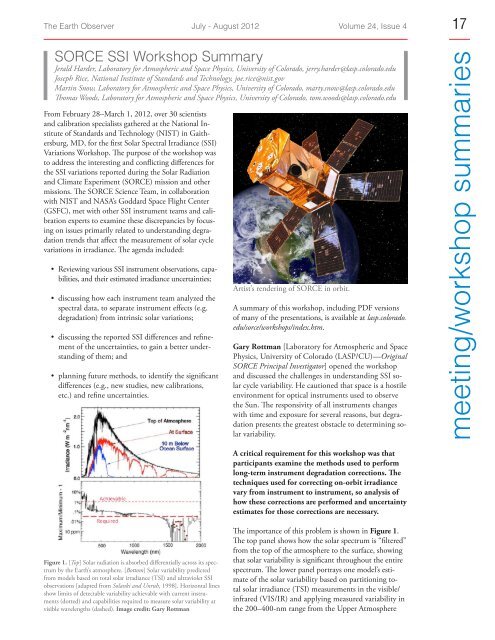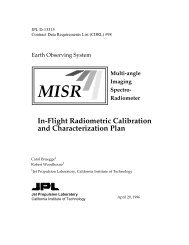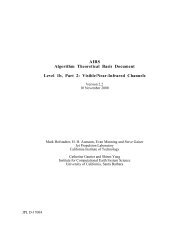Download - NASA's Earth Observing System
Download - NASA's Earth Observing System
Download - NASA's Earth Observing System
Create successful ePaper yourself
Turn your PDF publications into a flip-book with our unique Google optimized e-Paper software.
The <strong>Earth</strong> Observer July - August 2012 Volume 24, Issue 4 17<br />
SORCE SSI Workshop Summary<br />
Jerald Harder, Laboratory for Atmospheric and Space Physics, University of Colorado, jerry.harder@lasp.colorado.edu<br />
Joseph Rice, National Institute of Standards and Technology, joe.rice@nist.gov<br />
Martin Snow, Laboratory for Atmospheric and Space Physics, University of Colorado, marty.snow@lasp.colorado.edu<br />
Thomas Woods, Laboratory for Atmospheric and Space Physics, University of Colorado, tom.woods@lasp.colorado.edu<br />
From February 28–March 1, 2012, over 30 scientists<br />
and calibration specialists gathered at the National Institute<br />
of Standards and Technology (NIST) in Gaithersburg,<br />
MD, for the first Solar Spectral Irradiance (SSI)<br />
Variations Workshop. The purpose of the workshop was<br />
to address the interesting and conflicting differences for<br />
the SSI variations reported during the Solar Radiation<br />
and Climate Experiment (SORCE) mission and other<br />
missions. The SORCE Science Team, in collaboration<br />
with NIST and NASA’s Goddard Space Flight Center<br />
(GSFC), met with other SSI instrument teams and calibration<br />
experts to examine these discrepancies by focusing<br />
on issues primarily related to understanding degradation<br />
trends that affect the measurement of solar cycle<br />
variations in irradiance. The agenda included:<br />
• Reviewing various SSI instrument observations, capabilities,<br />
and their estimated irradiance uncertainties;<br />
• discussing how each instrument team analyzed the<br />
spectral data, to separate instrument effects (e.g.<br />
degradation) from intrinsic solar variations;<br />
• discussing the reported SSI differences and refinement<br />
of the uncertainties, to gain a better understanding<br />
of them; and<br />
• planning future methods, to identify the significant<br />
differences (e.g., new studies, new calibrations,<br />
etc.) and refine uncertainties.<br />
Artist’s rendering of SORCE in orbit.<br />
A summary of this workshop, including PDF versions<br />
of many of the presentations, is available at lasp.colorado.<br />
edu/sorce/workshops/index.htm.<br />
Gary Rottman [Laboratory for Atmospheric and Space<br />
Physics, University of Colorado (LASP/CU)—Original<br />
SORCE Principal Investigator] opened the workshop<br />
and discussed the challenges in understanding SSI solar<br />
cycle variability. He cautioned that space is a hostile<br />
environment for optical instruments used to observe<br />
the Sun. The responsivity of all instruments changes<br />
with time and exposure for several reasons, but degradation<br />
presents the greatest obstacle to determining solar<br />
variability.<br />
meeting/workshop summaries<br />
A critical requirement for this workshop was that<br />
participants examine the methods used to perform<br />
long-term instrument degradation corrections. The<br />
techniques used for correcting on-orbit irradiance<br />
vary from instrument to instrument, so analysis of<br />
how these corrections are performed and uncertainty<br />
estimates for those corrections are necessary.<br />
Figure 1. [Top] Solar radiation is absorbed differentially across its spectrum<br />
by the <strong>Earth</strong>’s atmosphere. [Bottom] Solar variability predicted<br />
from models based on total solar irradiance (TSI) and ultraviolet SSI<br />
observations [adapted from Solanki and Unruh, 1998]. Horizontal lines<br />
show limits of detectable variability achievable with current instruments<br />
(dotted) and capabilities required to measure solar variability at<br />
visible wavelengths (dashed). Image credit: Gary Rottman<br />
The importance of this problem is shown in Figure 1.<br />
The top panel shows how the solar spectrum is “filtered”<br />
from the top of the atmosphere to the surface, showing<br />
that solar variability is significant throughout the entire<br />
spectrum. The lower panel portrays one model’s estimate<br />
of the solar variability based on partitioning total<br />
solar irradiance (TSI) measurements in the visible/<br />
infrared (VIS/IR) and applying measured variability in<br />
the 200–400-nm range from the Upper Atmosphere







